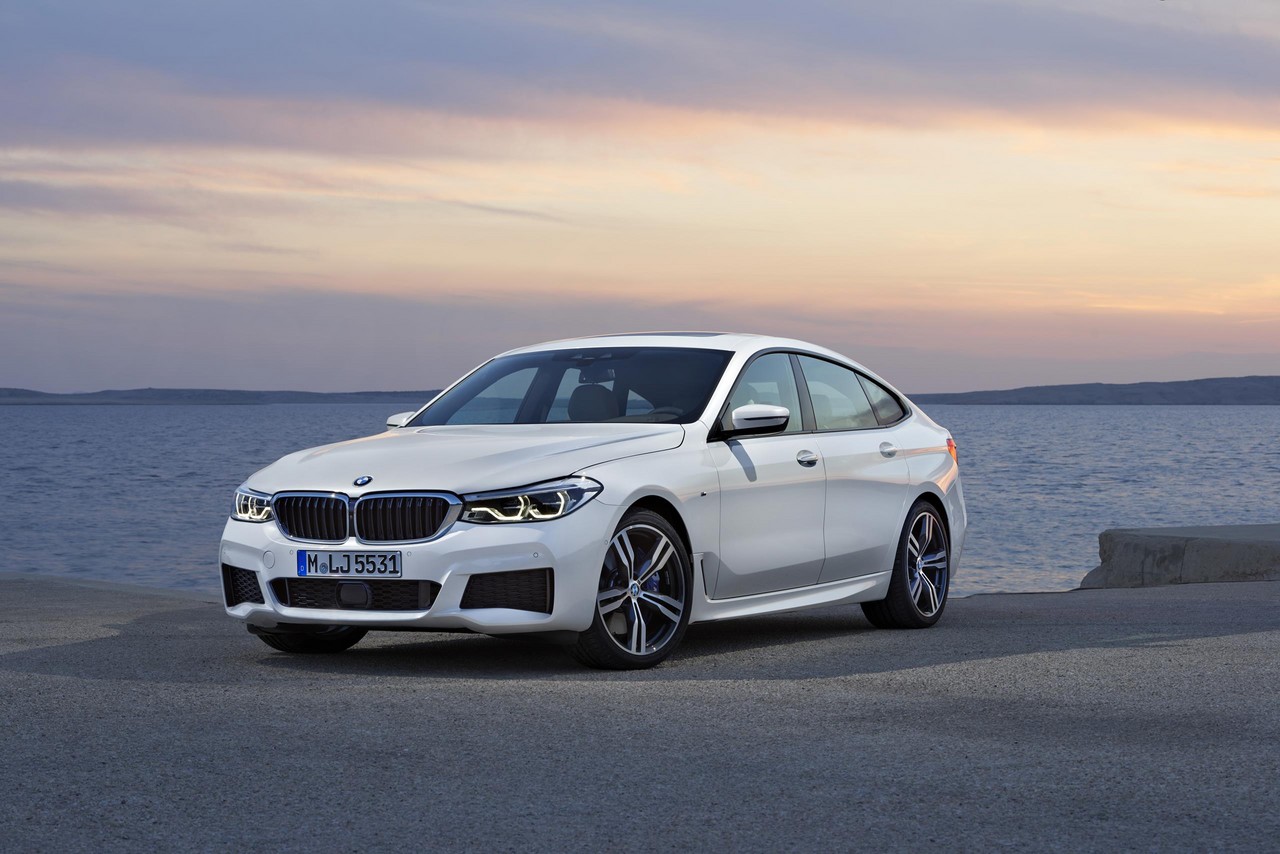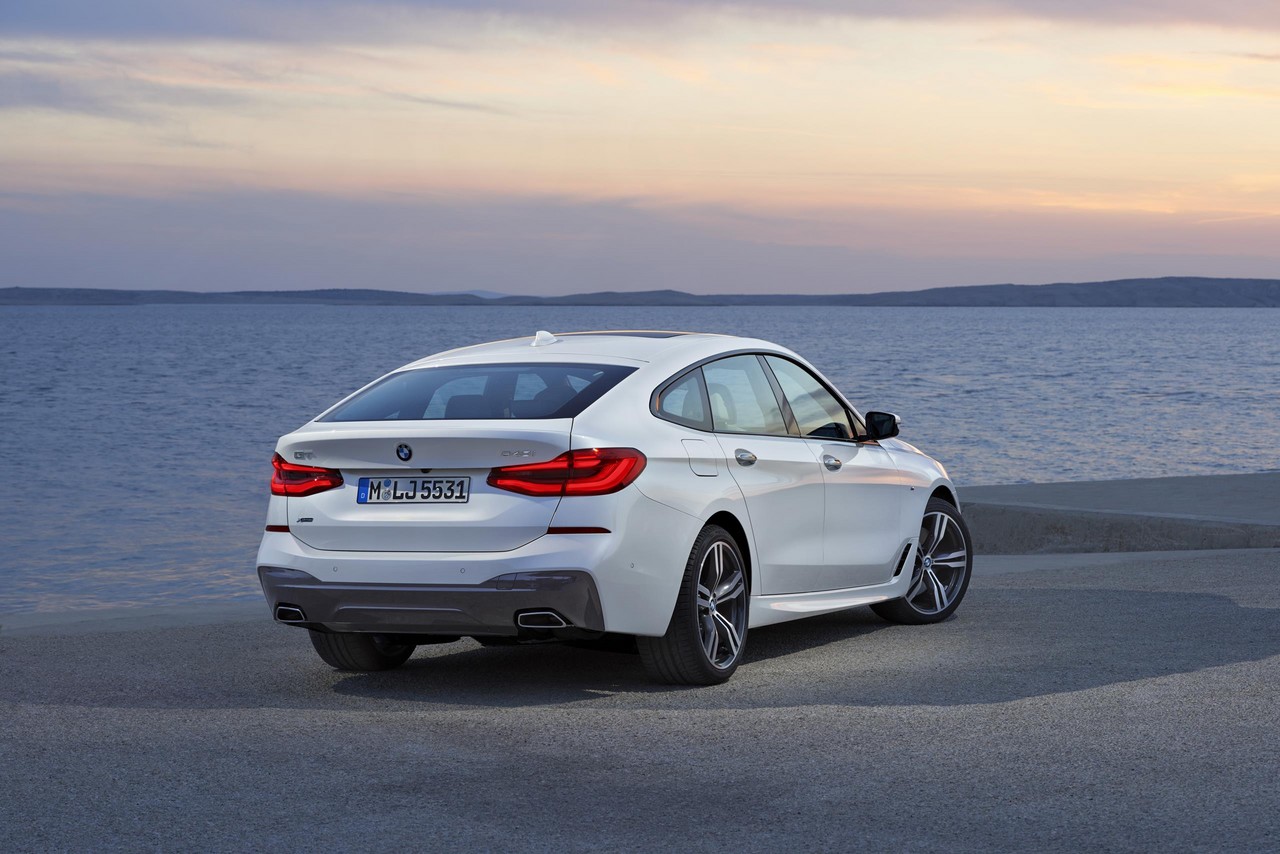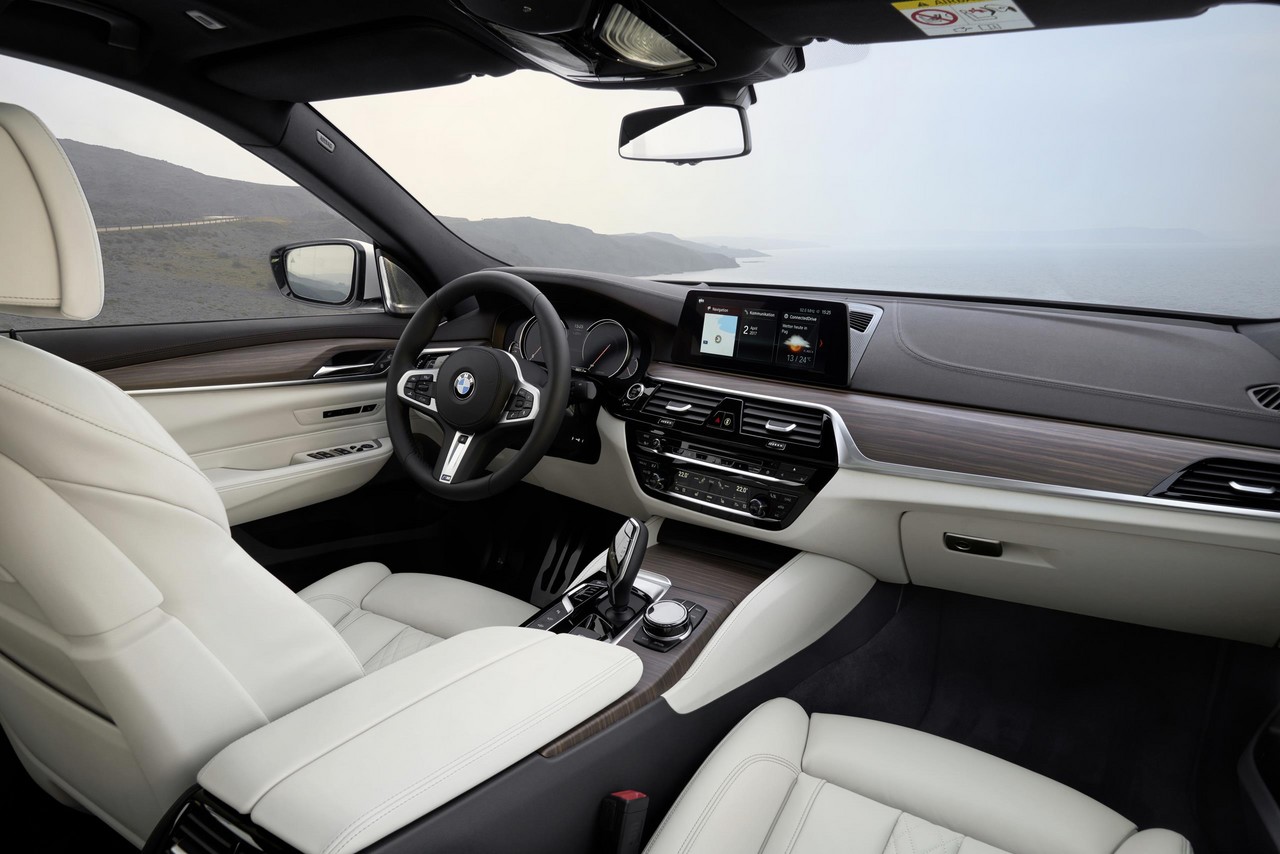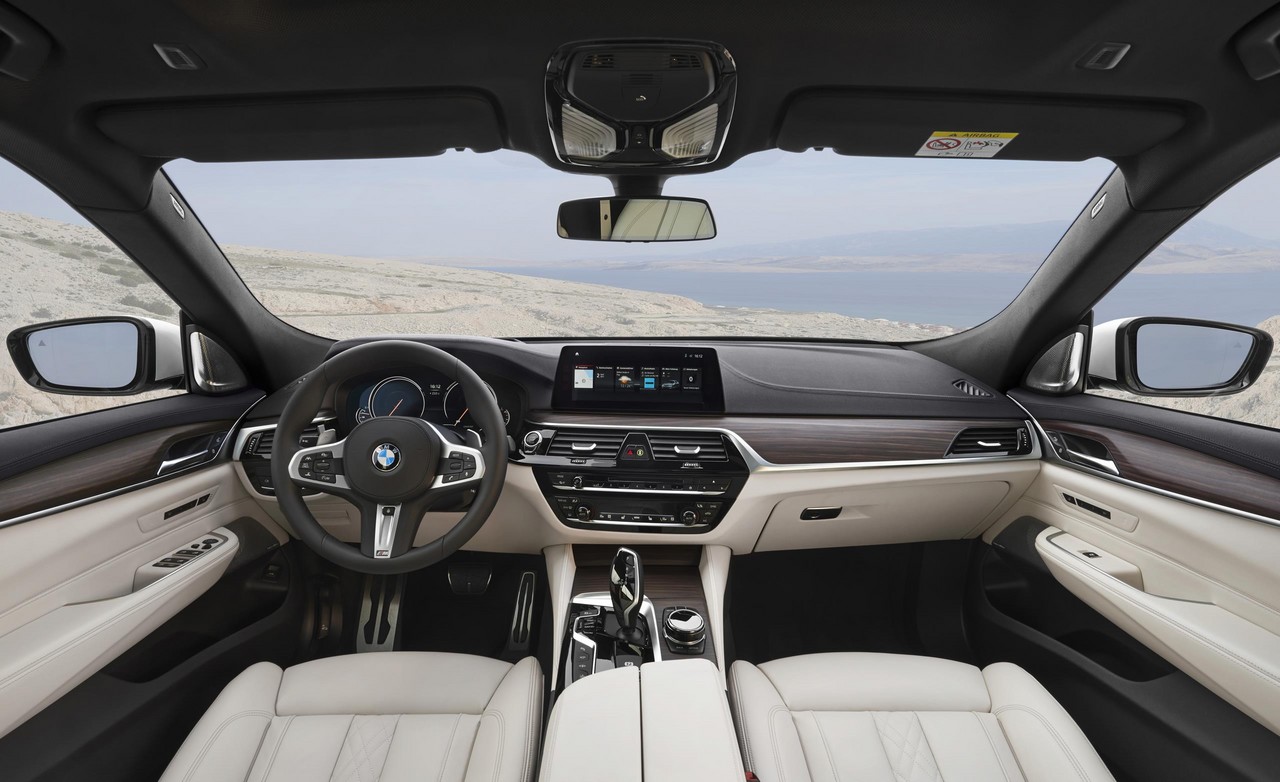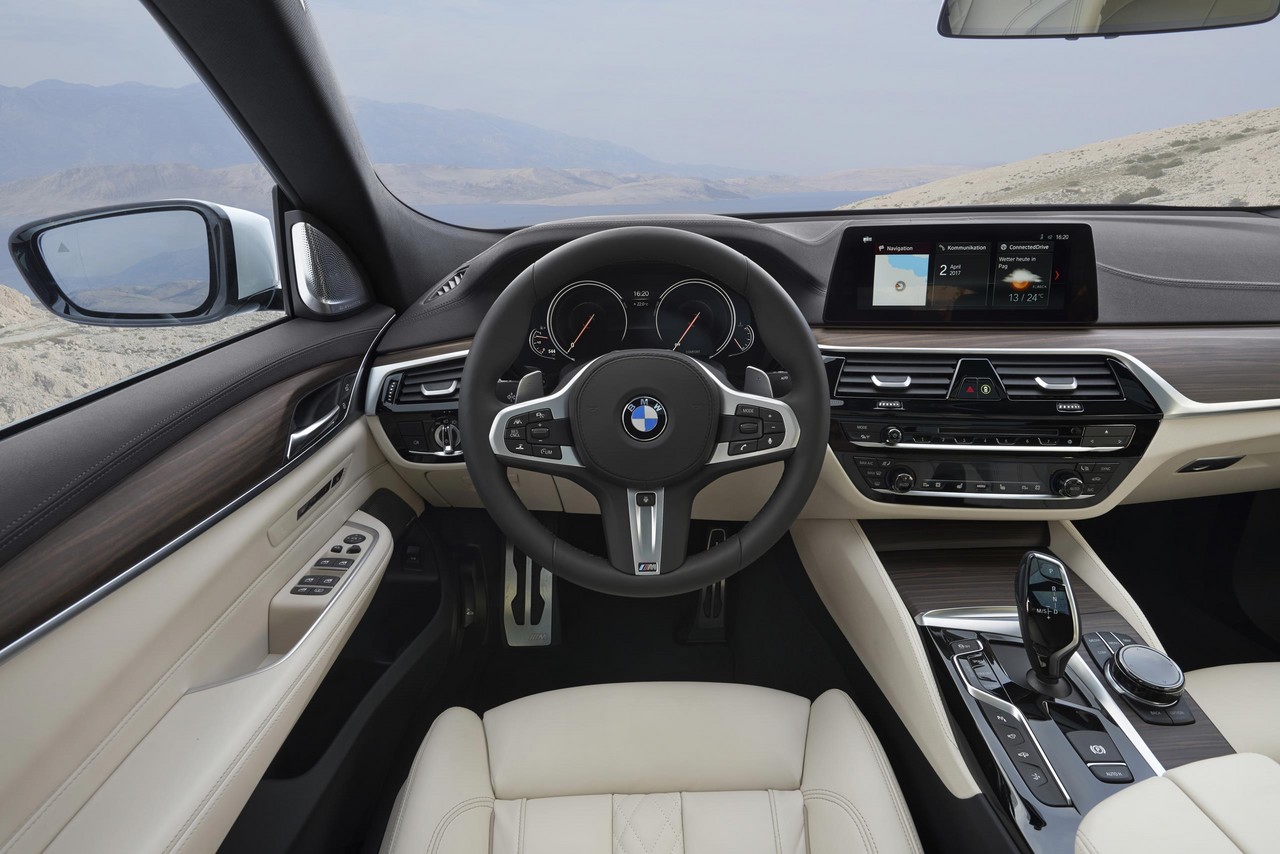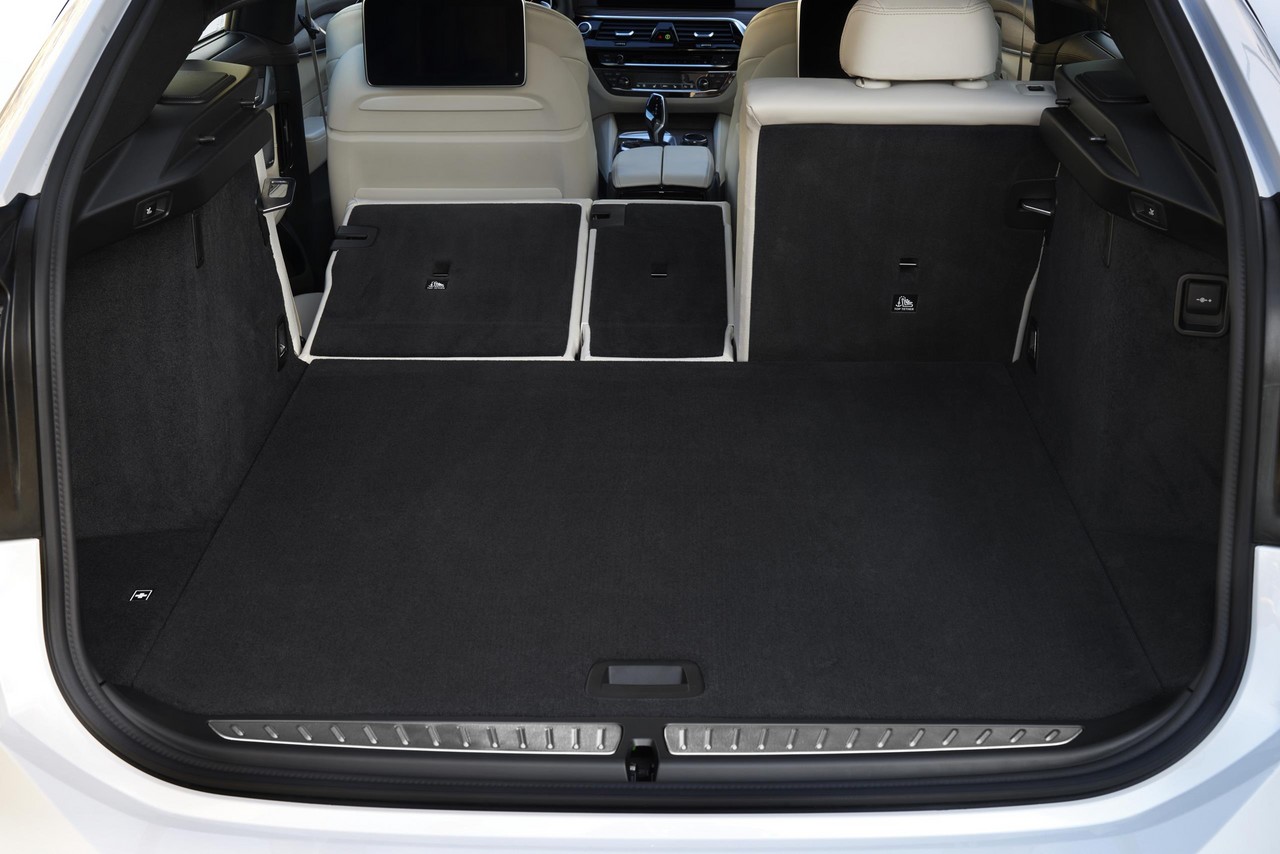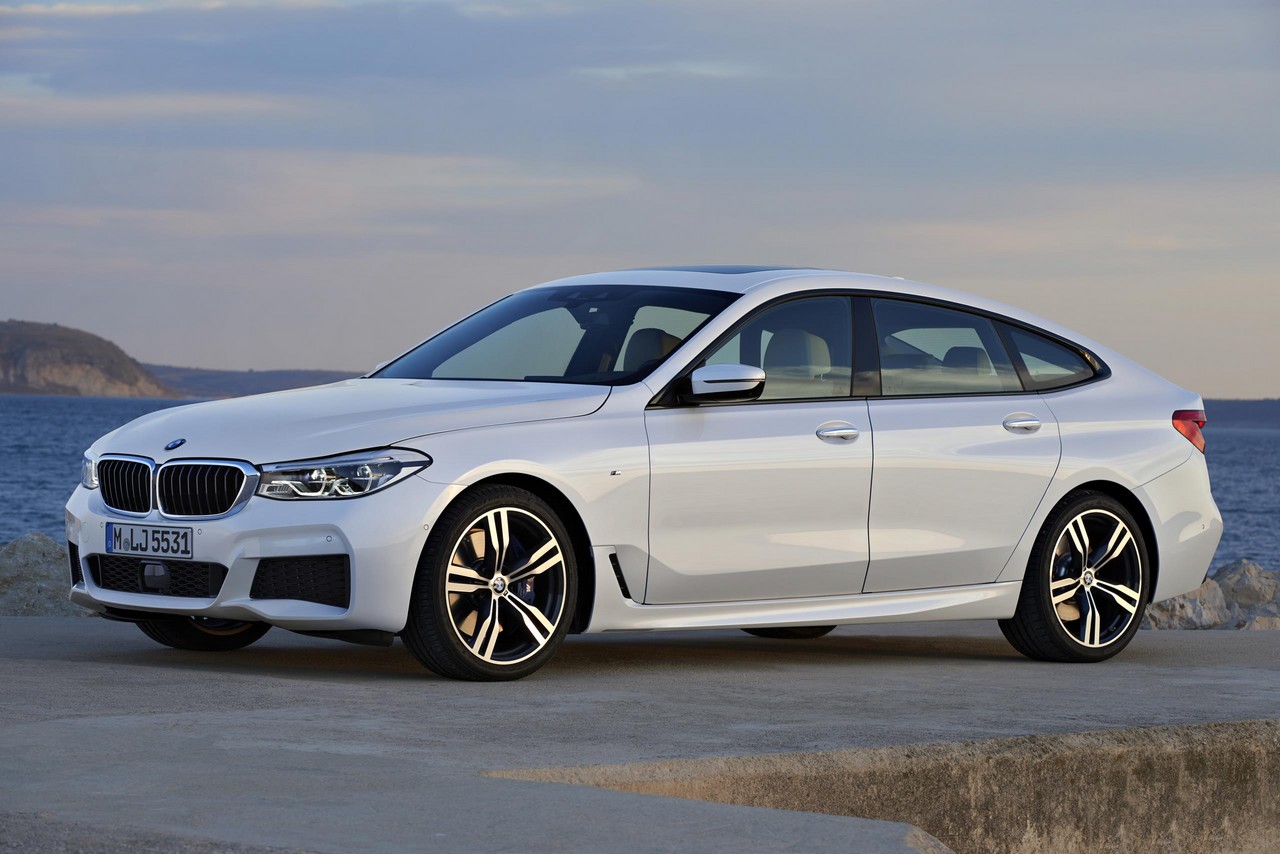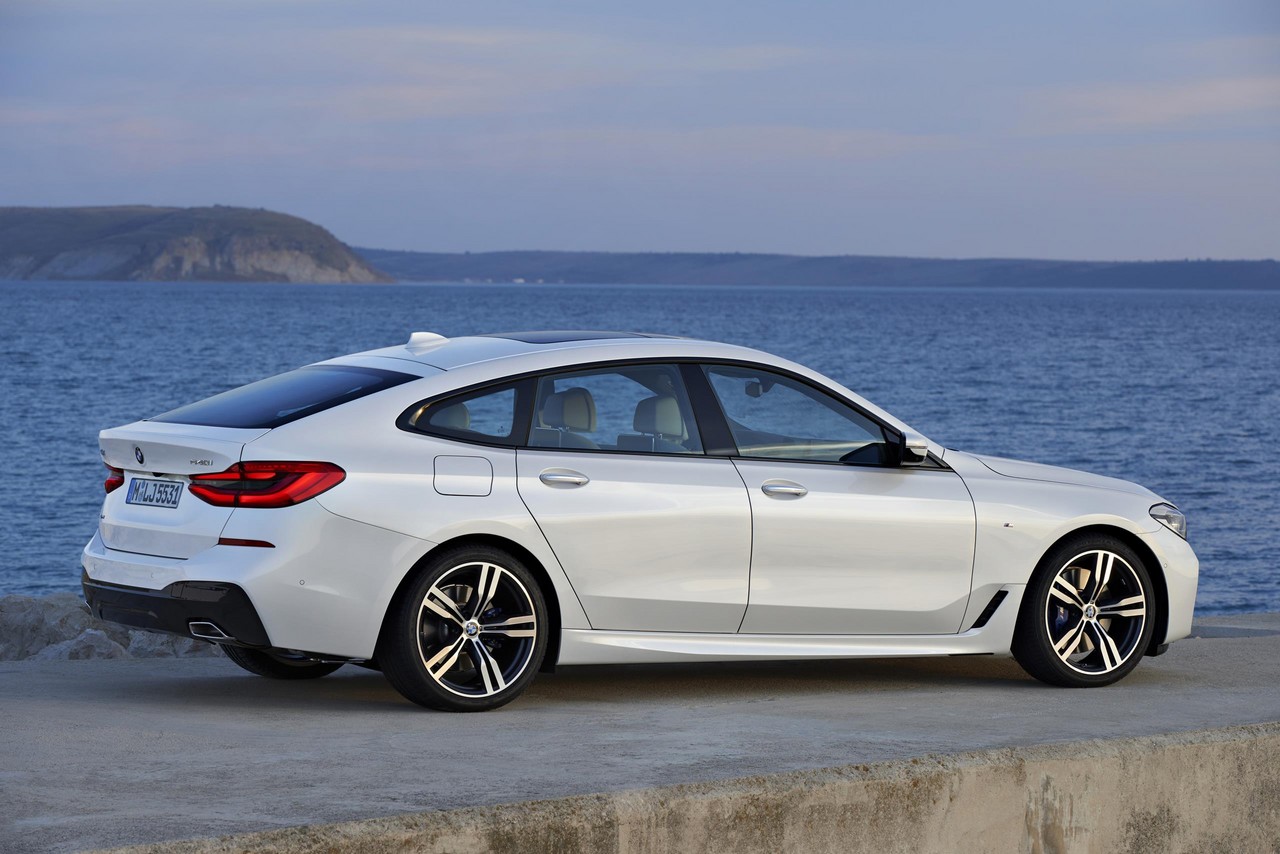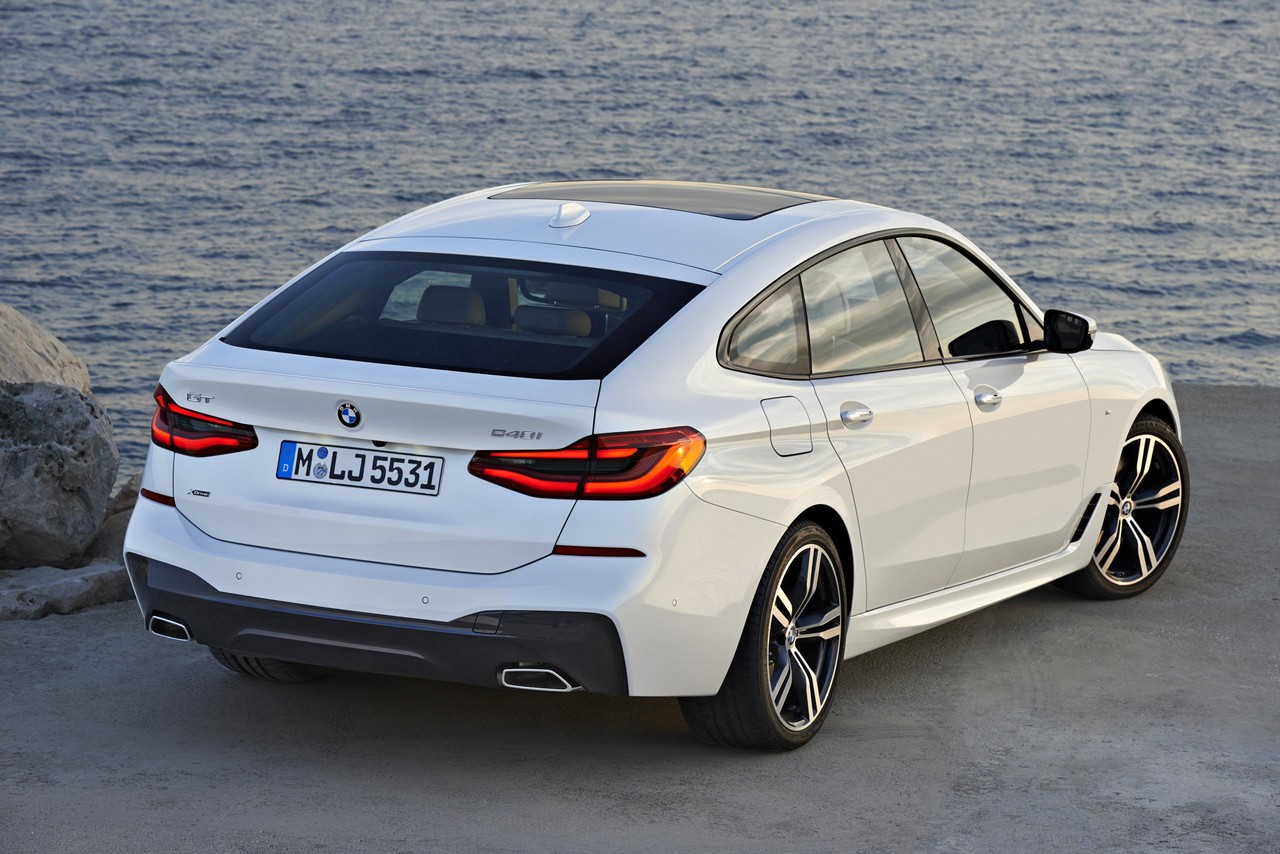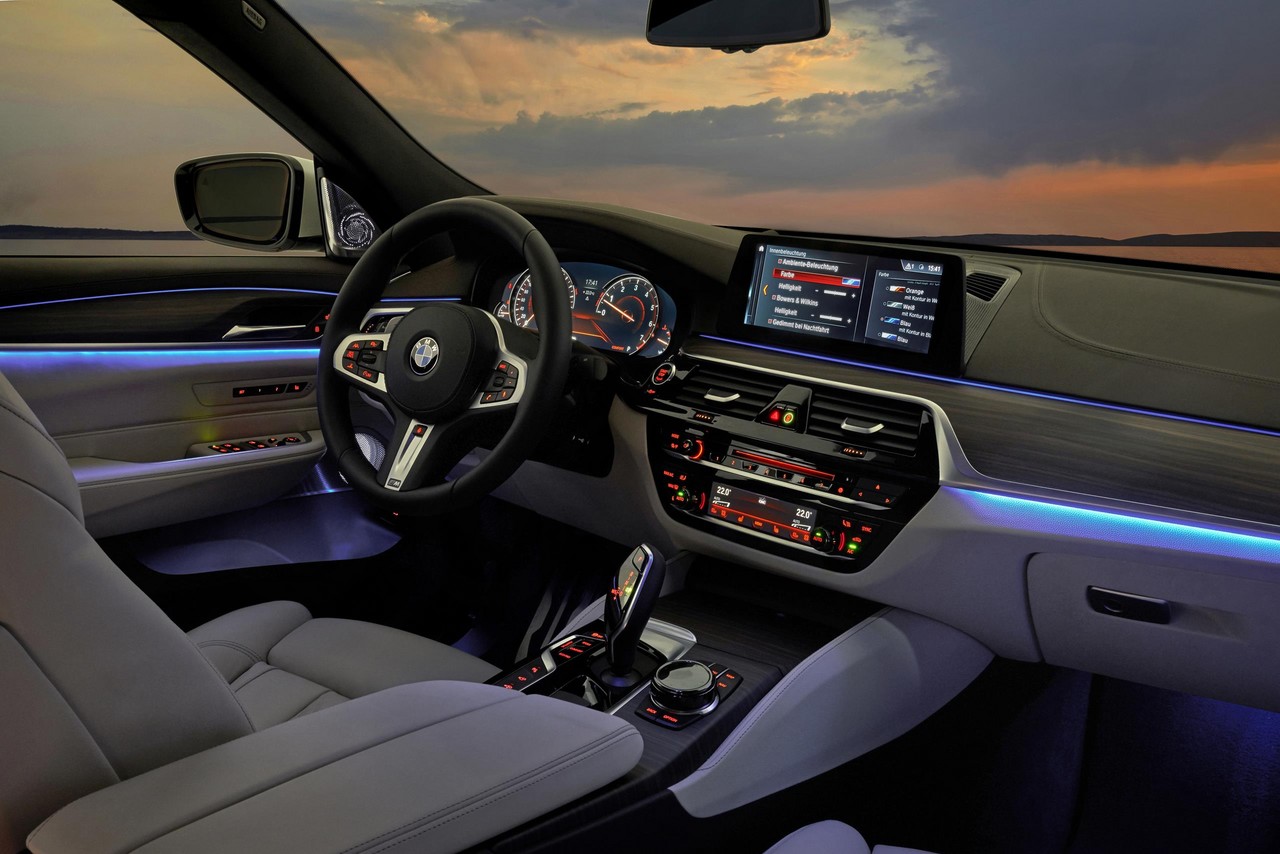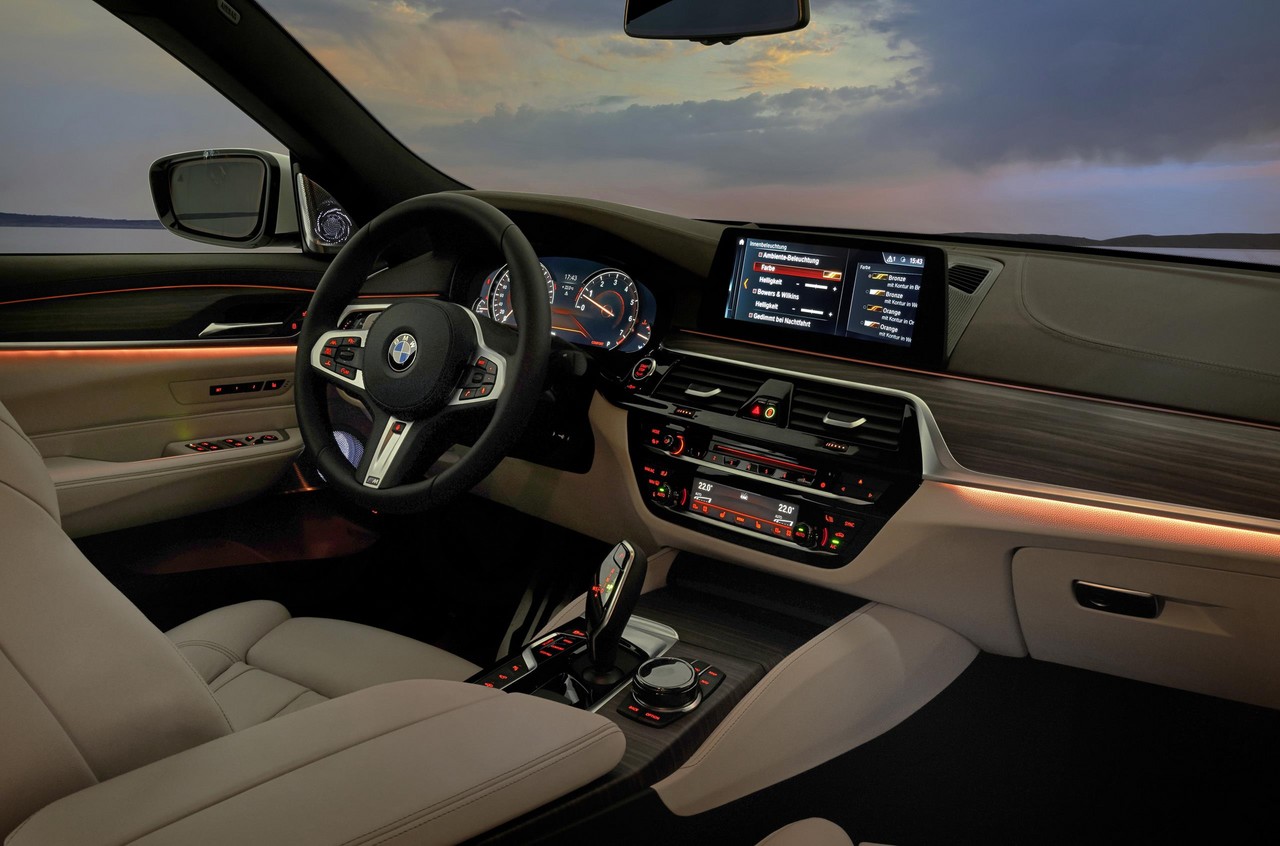
- Spacious interior
- Refined eight-speed ZF transmissions
- Linear accelerator pedal and progressive brake pedal
- Adaptive dampers and air springs provide impressive ride quality
- Quiet, well-insulated cabin
- Large cargo bay (610 litres)
- Light steering lacks feel
- Weight and high centre of gravity prevent it from being the ‘ultimate driving machine’
- Unconvincing styling
- High retail pricing
Overview
Released in Australia in October 2017, the BMW 6-Series Gran Turismo (chassis code: G32) was an executive liftback with five seats. Manufactured in Germany, the BMW G32 6-Series Gran Turismo range for Australia consisted of rear-wheel drive 630i and all-wheel drive 640i xDrive models. The BMW G32 6-Series Gran Turismo replaced the F07 5-Series Gran Turismo which was produced from 2010 to 2017.
In September 2018, the BMW 6-Series Gran Turismo range will be expanded with a 620d model.
EfficientDynamics
To reduce fuel consumption, the BMW G32 6-Series Gran Turismo had the following ‘EfficientDynamics’ measures –
- Auto Start Stop: could shut down the engine when the vehicle was stationary in traffic to reduce fuel consumption;
- Brake Energy Regeneration: regulated alternator output to recharge the battery when the vehicle was coasting or braking, thereby reducing load when accelerating;
- ‘Eco Pro’ drive mode: adjusted engine management and throttle response, and included a coasting function which disengaged the drivetrain to reduce engine braking;
- Active air flap control: the air flap in the grille only opened when air cooling requirements increased;
- Air Curtains: vertical apertures which guided inflowing air around the wheel arches to create a curtain of air over the wheels;
- Air Breathers: once air was deflected around the wheel arches, it was channelled through the Air Breathers (positioned behind the front wheels) to reduce turbulence; and,
- An active rear spoiler: automatically extended when vehicle speed exceeds 120 km/h and retracted when it slowed below 80 km/h.
| Engine | Trans. | Peak power | Peak torque | |
|---|---|---|---|---|
| 620d | 1995 cc B47D20O0 turbo diesel I4 | 8sp auto | 140 kW at 4000 rpm | 400 Nm at 1750-2500 rpm |
| 630i | 1998 cc B48B20 turbo petrol I4 | 8sp auto | 190 kW at 5000-6500 rpm | 400 Nm at 1550-4400 rpm |
| 640i xDrive | 2998 cc B58B30M0 turbo petrol I6 | 8sp auto | 250 kW at 5500-6500 rpm | 450 Nm at 1380-5200 rpm |
Body and dimensions
Compared to the BMW F07 5-Series Gran Turismo , the G32 6-Series Gran Turismo was 87 mm longer (at 5091 mm) and 21 mm lower (1538 mm), though width (1902 mm) and wheelbase length (3070 mm) were unchanged. Inside, the G32 6-Series Gran Turismo had a luggage capacity of 610 litres. When the 40:20:40 split rear seat backrest was folded down (from the passenger compartment or via an electric remote release using a button in the boot), luggage capacity increased to 1800 litres.
Relative to the F07 5-Series Gran Turismo, the G32 6-Series Turismo was around 150 kilograms lighter, with mass reduction measures including:
- A steel/aluminium compound construction, galvanised and hot-formed steels, and cold-formed steel plates with a zinc/magnesium coating;
- A laser welding technique for the aluminium door shells;
- A glass-fibre reinforced plastic acoustic shielding for the inner door panelling; and,
- Aluminium for the bonnet, doors, tailgate, engine cross-member, spring struts and rear trailing arms.
Styling cues for the G32 6-Series Gran Turismo included its kidney grille, long bonnet, flared wheel arches, raked A-pillars, set-back positioning of the cabin, doors with frameless windows, slim window graphic which extends into the rear end and L-shape tail-lights. In international markets, the G32 6-Series Gran Turismo had a drag co-efficient of 0.25 Cd for the 630d (0.26 Cd for the 630i and 640i). For the Australian-delivered 630i and 640i xDrive, however, the drag co-efficient was 0.28 Cd.
Suspension
The BMW G32 6-Series Gran Turismo had double wishbone front suspension and five-link rear suspension. As standard, Australian-delivered G32 6-Series Gran Turismo vehicles were specified with:
- BMW’s Adaptive Suspension with Dynamic Damper Control (i.e. electronically controlled dampers); and,
- Air suspension for the front and rear axle axles.
For the air suspension, air was supplied by an electrically powered compressor with pressure reservoir. Since the air supply was controlled individually for each wheel, it was possible to compensate for an unevenly distributed load and maintain an even ride height. The two-axle air suspension system also enabled owners to set the car’s ride height manually –
- Ground clearance could be raised by 20 mm for ramps;
- At speeds above 35 km/h, the self-levelling system reverted to the standard setting; and,
- A 10 mm reduction in ride height could be initiated by pressing a button – this happened automatically at speeds over 120 km/h and when ‘Sport’ mode was selected via the Driving Experience Control switch.
As an extra-cost option, the G32 640i xDrive could be specified with active anti-roll bars.
Steering
The BMW 6-Series Gran Turismo had rack-and-pinion steering with speed-sensitive, electric power assistance (BMW’s ‘Servotronic’); the steering ratio was 16.3:1.
As standard, the 640i xDrive Gran Turismo was equipped with rear-wheel steering which could turn the rear wheels by up to 2.5 degrees. At speeds of up to 60 km/h, the rear wheels turned in the opposite direction to the front wheels, thereby reducing the car’s turning circle and the amount of steering effort required. At higher speeds, however, the rear wheels turned in the same direction as the front wheels for greater stability.
Safety equipment
Standard safety equipment for the BMW G32 6-Series Gran Turismo included dual front airbags, front seat-mounted side airbags, full-length curtain airbags (i.e. for front and rear occupants), ABS, electronic brake force distribution, brake assist, electronic stability control, traction control, active front seat head restraints and front seatbelts with pre-tensioners and load limiters.
As standard, the G32 6-Series Gran Turismo was equipped with BMW’s ‘Driving Assistant Plus’ which included the following technologies –
- Approach control and person warning with city braking function: operating at speeds from 10 km/h to 60 km/h for pedestrian detection and up to 80 km/h for vehicle detection, the approach control warning system would initially warn the driver if there was a risk of a frontal collision. In its second stage, the braking system was prepared for faster response and, if the driver failed to react, autonomous emergency braking (AEB) would be initiated to reduce vehicle speed;
- Lane Change Warning: active at speeds above 10 km/h, Lane Change Warning monitored the zones to each side of the vehicle. If the driver activates the indicators to change lanes, the system would check these zones and – if occupied – warn the driver via steering wheel vibrations and flashing a symbol in the respective door mirror;
- Lane Departure Warning: active at speeds above 72 km/h, the driver would be alerted by steering wheel vibrations if the vehicle deviated from its lane without prior activation of the indicators;
- Rear collision prevention: if a rear-end collision was anticipated, following traffic would be warned by double frequency flashing of the hazard lights;
- Active Cruise Control with Stop&Go function: at speeds from 30 km/h to 210 km/h, Active Cruise Control could maintain a speed-dependent distance from the vehicle ahead. With the Stop&Go function, the vehicle could apply the brakes to bring the vehicle to rest and, once the traffic ahead began to accelerate, automatically accelerate if the vehicle had been stationary for a period of less than 30 seconds;
- Lane Change Assistant: operating at speeds between 70 km/h and 180 km/h, Lane Change Assistant could be activated by a long press of the direction indicator. The 6-Series Gran Turismo would then use its sensors to check if the adjacent lane was clear and that there was no other vehicle approaching at high speed in that lane. If safe to do so, the system would then ‘automatically assist’ the lane change manoeuvre;
- Lane Keeping Assistance: helped the driver pre-empt hazards by automatically applying corrective steering in three types of situation: 1) if the system detected that the vehicle was about to leave the road, 2) if the driver was about to change lane and had overlooked a vehicle in the next lane or 3) if danger was detected due to an approaching vehicle;
- Steering and lane control assistant: operating at speeds up to 210 km/h, the steering and lane control assistant provided ‘comfort-enhancing steering interventions’ to keep the vehicle in its current lane (even where road markings are unclear). In stop-start traffic, the system also used the preceding vehicle as a reference point;
- Side Collision Warning (also known as ‘Active Side Collision Protection’): operating at speeds between 30 km/h and 210 km/h, Side Collision Warning alerted drivers via a visual signal or steering wheel vibration if another vehicle was ‘encroaching’ from the side. If the system detected sufficient room on the other side of the vehicle, it would correctively steer the vehicle in this direction to avoid the danger. The corrective steering assistance, however, could be over-ridden by the driver at any time;
- Crossing traffic warning front: used radar sensors to check for approaching traffic at junctions with poor or impeded visibility;
- Crossing-traffic warning rear: when reversing out of a parking space, ‘Crossing-traffic warning rear’ warned the driver of approaching traffic that may intersect the driver’s projected path;
- Crossroads warning: comprised two ‘partial’ functions to provide warnings in 1) priority situations (i.e. where vehicles in another road had priority) and 2) at stop signs. In these situations, Crossroads warning would provide additional steering to warn of crossing traffic in a speed range of up to 84 km/h (visual advance warning and acoustic warning);
- Evasion aid: operating at speeds up to 160 km/h, the evasion aid ‘support[ed] the necessary evasive steering action’ if a swift lane change was required because an obstacle suddenly appeared in the driver’s path; and,
- Speed Limit Info: incorporated speed restrictions into the driver-selectable Speed Limiter function or Active Cruise Control (where fitted).
As standard, the G32 6-Series Gran Turismo was also fitted with –
- BMW’s ‘Active Protection’: if a collision risk was detected, including from preceding vehicles or stationary objects, Active Protection would activate the front seatbelt tensioners and closes the windows (and sunroof, where fitted). After a collision, Active Protection would automatically apply the brakes to bring the vehicle to rest, thereby reducing the likelihood and potential severity of a secondary collision; and,
- An ‘active bonnet’ which had pyrotechnic actuators in the bonnet hinges. In the event of a pedestrian collision, the actuators would deploy and locks would keep the bonnet in a raised position to provide additional deformation space between the bonnet and hard structures beneath it.
Euro NCAP safety rating
In Euro NCAP testing , the BMW 6-Series Gran Turismo received a five star safety rating which included an 86 per cent adult occupant protection rating, an 85 per cent child occupant protection rating and a 59 per cent ‘safety assist’ rating. Since the 6-Series Gran Turismo shared its platform and much of its structure with the G30 5-Series and had the same level of safety equipment, some tests for its assessment were carried over. Additional tests, however, were performed where differences might exist.
In the frontal offset test, protection of the driver’s head and feet were rated as good, but chest and lower leg protection were rated as adequate – a penalty was also applied to because the knee airbag did not deploy correctly. While maximum points were awarded in the side impact test, chest protection in the more severe pole test was rated as adequate.
Features: BMW G32 630i Gran Turismo
For Australian-delivered vehicles, standard features for the G32 630i Gran Turismo included BMW’s ‘iDrive6′ infotainment system, Professional’ navigation system with a 10.25 inch touchscreen, a 12.3-inch instrument display screen, harman kardon sound system with sixteen (16) speakers, digital radio tuner (DAB), Bluetooth mobile phone connectivity and audio streaming, voice recognition, wireless smartphone charging, four 12 volt power outlets and two USB sockets.
Beyond this, the G32 630i Gran Turismo was equipped with 19-inch alloy wheels, Dakota leather upholstery, power adjustable and heated front seats, dual-zone climate control air conditioning, adaptive LED headlights, dusk-sensing headlights, rain-sensing wipers, a head-up display, a leather-wrapped steering wheel with gearshift paddles, 40:20:40 split and folding rear seats, remote central locking with proximity key (BMW’s ‘Comfort Access’), power adjustable and heated door mirrors with power folding function, power windows, a power adjustable steering column (for height and reach), push-button start, a panoramic glass sunroof, ‘BMW Individual’ roofliner in Anthracite black, a power-operated tailgate, electrochromatic rear view mirrors, ambient lighting, tyre pressure monitoring, a trip computer and an immobiliser.
As standard, the BMW G32 6-Series Gran Turismo was also equipped with:
- BMW’s ‘Parking Assistant Plus’ which included front and rear parking sensors (‘Park Distance Control’), ‘Parking Assistant’ for park detection and automated steering inputs when parking in angled, perpendicular or parallel parking spaces, and a Surround View camera system; and,
- BMW ConnectedDrive Freedom which provided access to internet-based services, phone app-based Remote Services (including BMW Online and BMW Apps), real-time traffic information, concierge services and intelligent emergency call.
As standard, Australian-delivered BMW G32 6-Series Gran Turismo vehicles were equipped with an ‘M Sport Package’ as standard, which included an M Aerodynamics Package and M Sport brakes. As a no-cost option, however, the ‘Luxury Line’ specification could be chosen which included LED front fog lights, chrome window frames and inserts for illuminated door handles and a sport leather steering wheel. For the 630i Gran Turismo, the Luxury Line package also included four-zone climate control air conditioning, Nappa leather upholstery, ‘comfort’ front seats with active ventilation and power adjustable rear seats.
Features: BMW G32 640i xDrive Gran Turismo
Compared to the BMW 630i Gran Turismo, the 640i xDrive Gran Turismo was further equipped with 20-inch alloy wheels, Nappa leather upholstery, ‘comfort’ front seats with active ventilation, four-zone climate control air conditioning, power adjustable rear seats and power roller blinds for the rear side windows.
Related links
